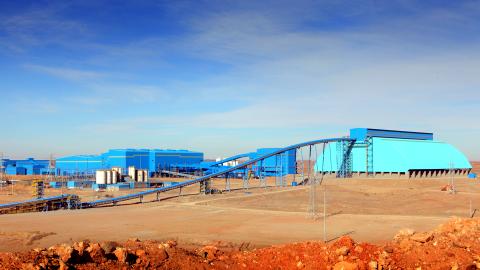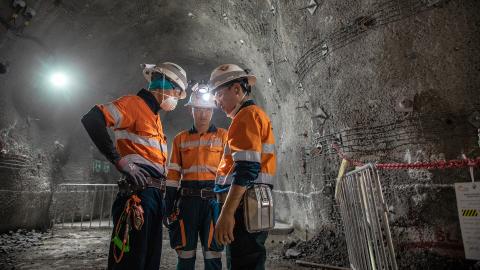Unearthing Benefits and Mitigating Adverse Environmental Impacts at Mongolia’s Oyu Tolgoi Mine:

Ulziilkham Enkhbaatar
PhD Student
Jun 24, 2025
Can Community Development Agreements deliver environmental justice for local mining-affected communities?
My doctoral research analyzes the impacts of Community Development Agreements (CDAs) on local communities in Mongolia. In particular, I consider whether CDAs can help mitigate adverse mining impacts by offering tangible benefits in the form of environmental stewardship, infrastructure development and local job creation in mining companies’ efforts to obtain the so-called social licence to operate (SLO).
This was the topic of a presentation I gave recently at Allard’s Centre for Law and the Environment. In my presentation, I applied an environmental justice framework to the case of the Oyu Tolgoi (OT) gold and copper mine in Mongolia, where a CDA was implemented to offer benefit sharing arrangements for local communities.

Mining is notorious for its adverse impacts on the environment, rivers, forests and local communities. These impacts are particularly troubling for developing countries that lack conscientious enforcement of environmental regulations and human rights norms.
The benefits and harms of mining are distributed unevenly across the country’s vast territory, which is home to sparse but fearless local communities: herders with nomadic livelihoods since ancient times.
Following the collapse of the Soviet bloc to which Mongolia had aligned itself for 70 years, mining of raw materials has slowly but surely risen to the top of the country’s national economic developmental path due to the lack of sufficient alternative sustainable export markets. Mongolia’s transition to democracy has been a costly but unavoidable affair due to the unrivaled predominance of the liberal economic model led by the United States in the 1990s.
Currently, mining is the central force in the Mongolian economy, accounting for 27.3% of GDP, 94% of exports, 79% of foreign direct investment and 30% of the state budget revenue in 2024. The production of raw materials such as copper, gold and coal amounted to USD $5.3 billion per annum in 2020 and is growing rapidly.
The mining sector’s rapid growth has had massive social and environmental consequences. The onset of the neoliberal mining regime was accelerated by the adoption of internationally accepted mining codes that pushed for the strategic absence of the state as a regulator of the complex environmental and social impacts of mining practices.
Like the African countries that had experienced this phenomenon just a decade earlier, Mongolia experienced environmental devastation, population resettlement and impairment of herders’ livelihoods, including lack of access to pastureland and water resources.
These developments led to the widespread proliferation of local anti-mining resistance in the form of so-called “river movements.” These movements resisted the devastating effects of large-scale mining projects, in line with Mongolian herders’ longstanding reputation for environmental stewardship and harmonious co-existence with natural ecosystems.
In response to local environmental resistance and lobbying from environmentally conscious NGOs, the government of Mongolia introduced CDAs as a mechanism to facilitate benefit-sharing with local communities, appease local resistance and align Mongolia with international best practices.
Consequently, CDAs have emerged as a novel tool to help alleviate the adverse impacts of mining on local communities by offering tangible benefits in the form of environmental stewardship, local infrastructure development, local employment and local procurement.
CDAs are now mandated by Article 42(1) of the 2006 Mining Law of Mongolia, which requires mining companies to conclude agreements with local governments on environmental protection, mine exploration, infrastructure development and job creation. However, monitoring and enforcement of these obligations is lacking and local governments’ implementation of their legal obligation to hold public hearings before signing CDAs is haphazard at best.
Despite these shortcomings, my research indicates that with proper implementation, CDAs could potentially advance environmental justice by offering tangible benefits to local communities while mitigating adverse environmental impacts.
In the past, particularly in the US context, environmental justice activists have consistently pointed to the unequal, unfair and unjust imposition of environmental burdens on marginalized groups, especially racialized and low-income communities. They defined environmental justice as the fair distribution of environmental benefits and burdens in the population.
In practical terms, environmental justice can be materialized when people impacted by environmentally harmful decisions have a right to environmental information, a right to participate in environmental decision-making processes and a right to redress and compensation for environmental harms.
My distinctive contribution to environmental justice debates is to supplement a conventional environmental justice approach with the “capability approach” developed by the Nobel Prize-winning Indian economist Amartya Sen. Sen argues that justice (including environmental justice) is better served if goods increase individuals’ capabilities for a well-functioning human existence in society.
Almost two-thirds (65%) of Mongolians believe that mining benefits are not fairly distributed in the country. Environmental justice in the mining context is lagging in Mongolia. In this context CDAs constitute tangible benefit sharing arrangements for local communities. They have the potential to improve capabilities and advance environmental justice by, among other things, enhancing local people’s economic functioning through local hiring practices and local procurement and funding opportunities.
Let me explain my argument more concretely via the example of the Oyu Tolgoi CDA in Mongolia.

The Oyu Tolgoi (OT) Mine or “Turquoise Hill” in English, is located in Umnugobi (“South Gobi”) province. Its CDA was concluded in 2015 between the government of the province and the mine’s foreign investor, Rio Tinto. Rio Tinto now owns 66% of OT. The government of Mongolia owns the remaining 34%.
The OT CDA was the product of a four-year process that incorporated local community voices, culminating in the 4 years of deliberation and pre-negotiation stages involving the signing of MOU in 2011 and Process Agreement in 2012.

In the CDA, Oyu Tolgoi LLC promised that at least 90% of its employees would be Mongolian nationals. It has exceeded this target in practice: 97% of its employees, including 90% of those in leadership positions, are Mongolian nationals. The CDA also commits to support women. In practice, 23.3% of the workforce are women, of which 50% occupy senior management positions.
The locally hired personnel are trained in core technical skills through pre-employment apprenticeship programs to build their capacities for employment at the mine as operators and tradespeople.
In light of the above findings, it can be forcefully argued that CDAs can potentially become effective environmental justice tools for local communities because they offer tangible benefits to individuals and communities affected by development projects in the form of local employment and training opportunities that support their capabilities and functioning in the local job market.
The OT mine’s implementation of its obligations under its CDA related to local training and employment illustrates the realization of human capabilities to improve local livelihoods. Thus, CDAs can potentially advance environmental justice in the mining sector if the targeted benefits for local communities are achieved on the ground with concrete outcomes, as the high employment rate of Mongolian nationals at Oyu Tolgoi LLC illustrates.
- Centre for Law and the Environment


